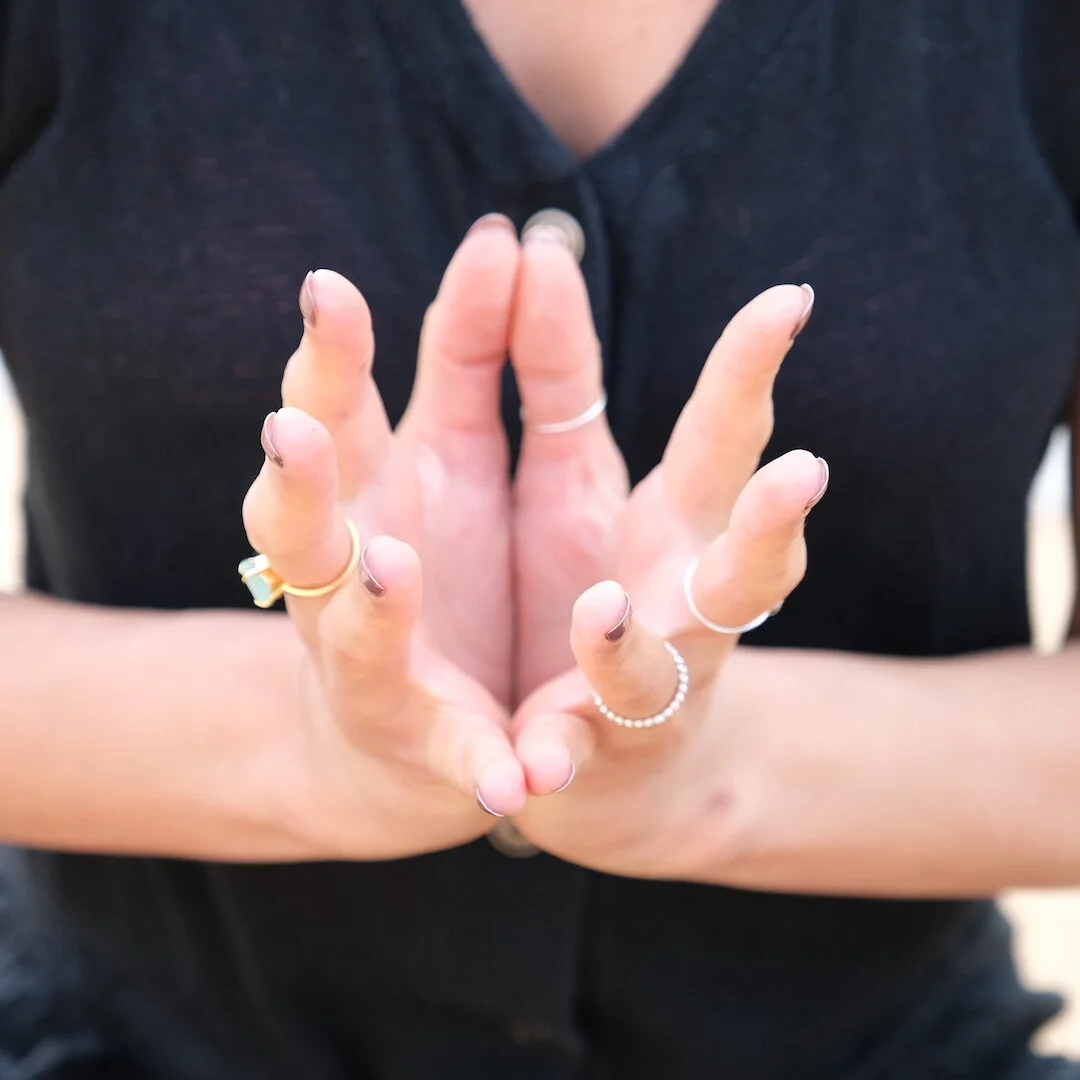5 Powerful Mudras and how to use them in your practice
The word Mudra literally means “seal”, “stamp”, or “gesture”. Mudras are sacred gestures, practiced with the hands and fingers. Mudras are a great tool to free up energy and direct it to areas of the body that need healing. It’s a way of deepening the practice as they enhance one’s journey within. Mudras are said to awaken the power of the Divine and have been used for thousands of years in many different traditions.
Every Mudra has a particular purpose and moves the energy in a specific way throughout the body to create subtle physical, mental, and emotional changes.
For example, in class you might have hear me say to either place your palms facing down or facing up on your legs in a meditation seat. Placing your palms face down on your thighs will usually calm and ground your energy, so perfect when you feel agitated, anxious or nervous. If you feel like you could need some more energy, a palms-up Mudra might enliven you.
So overall, the use of Mudras in your yoga practice is a powerful tool for self-care and empowerment. The intention in yoga is to draw yourself inward. Mudras allow us to go inward, balance and recharge the energy levels.
There are more than 100 known Mudras (I even read somewhere that it’s more than 1000). In this blogpost I will share 5 of my favourite Mudras, that I often use in my own practice and in my teachings.
Gyan Mudra
This might be one of the most familiar Mudras. If you ever joined one of my classes, for sure I gave the option to use this Mudra at the end of class while sitting in stillness. It’s a powerful hand gesture practiced for thousands of years by yogis that brings peace and calm into your mind and body. Furthermore it’s known to improve concentration and sharpen memory. So it’s a perfect Mudra to use in your meditation.
To practice Gyan Mudra:
Bring the tip of the thumb to touch the tip of the index finger on both hands.
Keep the remaining fingers out straight, but relaxed.
Ksepana Mudra
Another one I often use in my practice but also in my teaching. Ksepana Mudra is the Mudra of letting go, pour off or to cast off. It is used as a means of letting go of negative energy that can come from negative thoughts, negative feelings, toxic relationships, or old habits that don’t serve our highest self. I like to use this Mudra in a simple pranayama practice or breath awareness meditation when my mind is too busy, when I’m overthinking stuff, feeling ungrounded, anxious, nervous, or simply in a negative state.
To practice Ksepana Mudra:
Interlace all the fingers, beside the index fingers. (Index fingers point out)
Press the index fingers together, but ensure that there is a small hollow space between the palms of the hands.
Point the index fingers towards the ground.
Take some slow and even breaths, focussing on lengthening the exhalation or sighing out the breath (Clearing breaths)
Padma Mudra (Lotus Mudra)
This is a beautiful Mudra to enhance compassion and loving-kindness and also to calm the mind. Representing the purity and perseverance of the lotus flower floating above the muddy waters of desire, fear, and attachment, this Mudra also represents positive transformation, dissolving the layers of mud and muck to remind you of the natural beauty of your soul.
To practice Padma or Lotus Mudra:
Bring your hands softly into Prayer in front of the heart center.
Slowly unfurl your hands like a lotus flower blossoming open. Keep the base of the hands together, along with the thumbs and little fingers. Allow the index, middle, and ring fingers to gently open.
Anjali Mudra
This Mudra for sure is also a very familiar one to you. It’s the gesture we do when we express gratitude or say “Namasté” at the beginning or end of class. But we also use this Mudra frequently during the practice in different asanas, as well as during sun salutations. Anjali Mudra is used as a gesture of composure, of returning to one’s heart, whether you are greeting someone or saying goodbye, initiating or completing an action. When we bow with our hands in Anjali Mudra it’s like saying, “The light in me acknowledges the light in you” (this is also what “Namasté” means). Personally I also feel that the Mudra brings a feeling of humility and kindness to one’s heart. In postures like tree pose, or warrior three it helps to balance as we connect the left and right side. You can use this Mudra in any activity in which you want to be centered and conscious about your action.
To practice Anjali Mudra:
Simply bring your hands to prayer position in front of your heart center.
Hakini Mudra
This is a Mudra I like to use during the practice, in a pose like high lunge or warrior 1 when I feel I need some more power and concentration. The Mudra is believed to refresh and revitalize the brain, to enhance concentration, as well as communication and cooperation between both hemispheres of your brain. I also learned that this Mudra is named after the goddess Hakini. Hakini in Sanskrit means "power," so this Mudra is believed to give you power over your own mind.
To practice Hakini Mudra:
Bring the palms to face each other with a few inches between them.
Bring the tips of each finger to touch the matching finger on the other palm.
The hands can then be raised to touch the center of the forehead.
What’s your favourite Mudra and why?
How does it make you feel? Feel free to share in the comment section.






